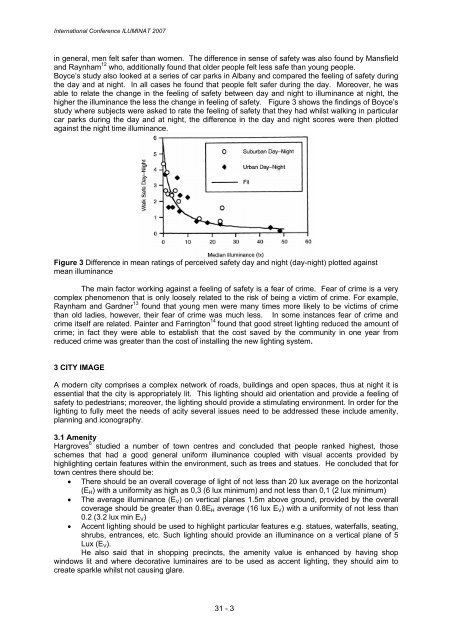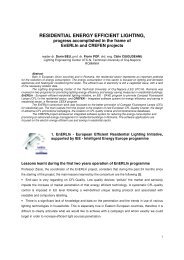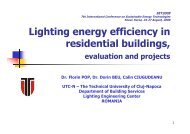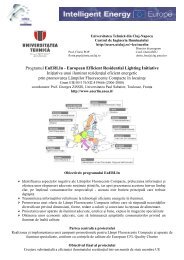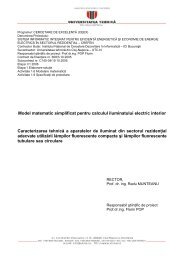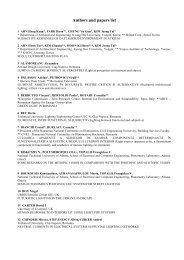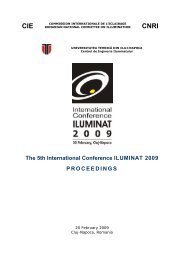1 June 2007 Cluj-Napoca, Romania - Lighting Engineering Center ...
1 June 2007 Cluj-Napoca, Romania - Lighting Engineering Center ...
1 June 2007 Cluj-Napoca, Romania - Lighting Engineering Center ...
You also want an ePaper? Increase the reach of your titles
YUMPU automatically turns print PDFs into web optimized ePapers that Google loves.
International Conference ILUMINAT <strong>2007</strong><br />
in general, men felt safer than women. The difference in sense of safety was also found by Mansfield<br />
and Raynham 12 who, additionally found that older people felt less safe than young people.<br />
Boyce’s study also looked at a series of car parks in Albany and compared the feeling of safety during<br />
the day and at night. In all cases he found that people felt safer during the day. Moreover, he was<br />
able to relate the change in the feeling of safety between day and night to illuminance at night, the<br />
higher the illuminance the less the change in feeling of safety. Figure 3 shows the findings of Boyce’s<br />
study where subjects were asked to rate the feeling of safety that they had whilst walking in particular<br />
car parks during the day and at night, the difference in the day and night scores were then plotted<br />
against the night time illuminance.<br />
Figure 3 Difference in mean ratings of perceived safety day and night (day-night) plotted against<br />
mean illuminance<br />
The main factor working against a feeling of safety is a fear of crime. Fear of crime is a very<br />
complex phenomenon that is only loosely related to the risk of being a victim of crime. For example,<br />
Raynham and Gardner 13 found that young men were many times more likely to be victims of crime<br />
than old ladies, however, their fear of crime was much less. In some instances fear of crime and<br />
crime itself are related. Painter and Farrington 14 found that good street lighting reduced the amount of<br />
crime; in fact they were able to establish that the cost saved by the community in one year from<br />
reduced crime was greater than the cost of installing the new lighting system.<br />
3 CITY IMAGE<br />
A modern city comprises a complex network of roads, buildings and open spaces, thus at night it is<br />
essential that the city is appropriately lit. This lighting should aid orientation and provide a feeling of<br />
safety to pedestrians; moreover, the lighting should provide a stimulating environment. In order for the<br />
lighting to fully meet the needs of acity several issues need to be addressed these include amenity,<br />
planning and iconography.<br />
3.1 Amenity<br />
Hargroves 6 studied a number of town centres and concluded that people ranked highest, those<br />
schemes that had a good general uniform illuminance coupled with visual accents provided by<br />
highlighting certain features within the environment, such as trees and statues. He concluded that for<br />
town centres there should be:<br />
• There should be an overall coverage of light of not less than 20 lux average on the horizontal<br />
(EH) with a uniformity as high as 0,3 (6 lux minimum) and not less than 0,1 (2 lux minimum)<br />
• The average illuminance (EV) on vertical planes 1.5m above ground, provided by the overall<br />
coverage should be greater than 0.8EH average (16 lux EV) with a uniformity of not less than<br />
0.2 (3.2 lux min EV)<br />
• Accent lighting should be used to highlight particular features e.g. statues, waterfalls, seating,<br />
shrubs, entrances, etc. Such lighting should provide an illuminance on a vertical plane of 5<br />
Lux (EV).<br />
He also said that in shopping precincts, the amenity value is enhanced by having shop<br />
windows lit and where decorative luminaires are to be used as accent lighting, they should aim to<br />
create sparkle whilst not causing glare.<br />
31 - 3


